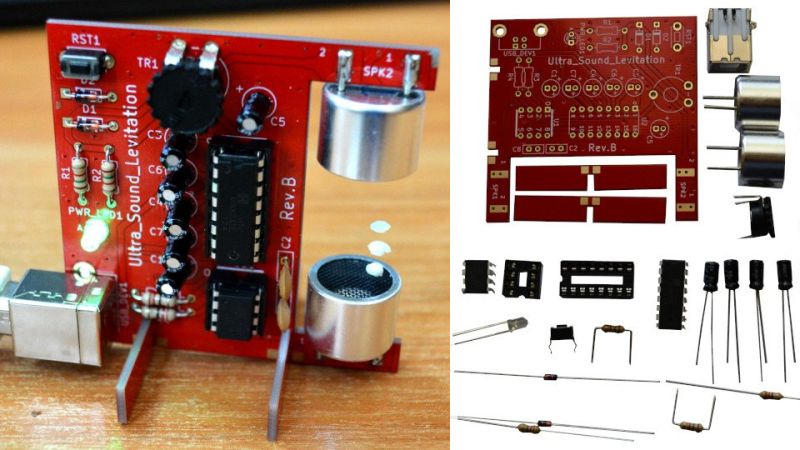For those that haven’t heard, ultrasonic levitation is a process by which two or more ultrasonic transducers are set opposite to each other and excited in such a way as to create a standing wave between them. The sound is, as the name implies, ultrasonic — so outside the range of human hearing — but strong enough so that the small, light objects can be positioned and held fixed in mid-air where there’s a pressure minimum in the standing wave. [Olimex] has created a small ultrasonic levitation kit that exemplifies this phenomena.
The kit itself is made using through-hole components, with an ATTiny85 as the core microcontroller to drive two TCT40-16T ultrasonic speakers, and a MAX232 to provide a USB interface drives the transducers (thanks to the folks in the comments for the correction). Two slotted rectangular PCB pieces that solder connect to the main board, provide a base so that the device stands upright when assembled. The whole device is powered through the USB connection, and the ultrasonic speakers output in the 40KHz range providing enough power to levitate small Styrofoam balls.
The project is, by design, an exercise in minimalism, providing a kit that can be easily assembled, and providing code that can be easily flashed onto the device, examined and modified. All the design files, including the bill of materials, KiCAD schematics, and source code are provided under an open source hardware license to allow for anyone wanting to know how such a project works, or to extend it themselves, ample opportunity. [Olimex] also has the kit for sale for those not wanting to source boards and parts themselves.
We’ve featured ultrasonic levitation devices before, from bare bones system driven by a NE555 to massive phased arrays.

















The MAX232 is driving the ultrasound transmitters, not the USB interface.
Thanks for the catch! I’ve updated the article to reflect the change.
>a MAX232 to provide a USB interface
Something is wrong here. Looking at the schematic you can see the MAX232 is (ab)used to drive the speakers, nothing to do with USB…
I knew it xD
Max232 is not meant for usb communications
Thanks for the catch! I’ve updated the article to reflect the change.
It is indeed very minimalistic (both the parts and schematic, but also the documentation). Just to clarify the description above, the MAX232 is not used for USB, but between the ATTiny’s square wave output and the ultrasonic buzzers. The USB data lines are directly connected to the ATTiny, but not used in the default program. I guess it’s mainly to reprogram the ATTiny once you’ve first flashed an ATTiny USB Bootloader (like micronucleus). The default program is “basically a NE555”, inverting the two output pins on the clock compare interrupt, and adjusting the compare register based on the analog read of the trim pot.
Although the project is certainly nicely done, and has room for experimenting and tweaking (the lines of each speaker could be controlled separately if one wished to; USB programming and access to USB data line should make it more convenient to fiddle with, etc.), I personnaly find the lack of explanation on the design choices a bit less exploratory-friendly for beginners (What’s the exact advantage of using the MAX232 to drive the speakers? Why is the ATTiny power dropped to ~3.5V by 2 diodes? While the USB data input is still at full 5V (almost 1V above recommended max…)? )
a tiny micro with an additional USB interface chip would be far from minimalistic with the number of usb enabled micros…
> What’s the exact advantage of using the MAX232 to drive the speakers?
Larger voltage swing.
> Why is the ATTiny power dropped to ~3.5V by 2 diodes? While the USB data input is still at full 5V (almost 1V above recommended max…)? )
USB data lines are 3.3V.
Thanks! You prompted me to look back at the MAX232 datasheet, and it seems obvious now.
And I’m so used to seeing the D+ and D- connected directly to USB-specific pins that I totally forgot about their lower max voltage… 😅
Oh well, there’s no stupid question they say 🤦♂️
I would call the use of such an ubiquitous part as the MAX232 for the benefit of a higher peak to peak voltage than the provided 5V or even bridged 10V quite brilliant. Other ways to get a 30V amplitude would be way more complicated.
I agree. And both the ATTiny85 and the MAX232 (and the speakers, if you remove them from a pair of sonar sensors) are usually readily available in through-hole package and single-digit quantities, even sometimes in local brick-and-mortar electronic stores, which is a nice plus for weekend hobbyists or even just curious beginners.
Thanks for the catch on the MAX232! I’ve updated the article to reflect the change.
> ATTiny85
You have my attention!
\o/
Question: can loud enough ultrasound damage hearing even though it’s outside of the perceptible range?
apparently it does, but intesity fades quite rapidly with distance
https://www.hse.gov.uk/research/crr_pdf/2001/crr01343.pdf
And what about the hearing of pets (dogs, cats, birds)? I think this thing would drive them crazy, and possibly damage their hearing as well. Use only in a controlled environment?
Try to crank it down a notch, when you see your neighbor dog levitate.
6.95 EUR. Sell that on US Amazon and even with the necessary markup to still make a profit you’ll be cheaper than the cheapest kit currently found there which is US$19.58.
“For those that haven’t heard, ultrasonic…”
I see what you did there.
Never got it to work. Waste of money.